Colonial Williamsburg, May 2012
The events of the weekend were presented more as an educational and commemorative experience rather than as a reenactment of the events that took place on 4-6 May 1862. There were a small number of Civil War reenactors encamped in town who provided a glimpse into what the soldiers there might have experienced. While we were expecting this to be a larger event, I feel that it was a very proper homage in tone and scale. It was an especially moving experience for us, having recently discovered the roles that many of our ancestors played in the war. We were most especially honored to pay homage to our great-great-uncle James, who was actually present in Williamsburg on May 5, 1862 and fought with his unit in the battle.
I prepared for our Civil War excursion by (what else?!) dressing the part! This was our first encounter with recreating 1860s apparel and we had a fun time assembling my ensemble. Rebecca will be sharing more details about my gown and bonnet in some upcoming posts. I thoroughly enjoyed dressing for this "new" time period, although I definitely prefer my stays over a corset any day!
Saturday morning we arrived in town early to catch the first presentation in front of the Courthouse, which provided an overview of the events that led to, surrounded, and followed the Battle of Williamsburg. It was a bright and steamy day and everyone huddled in the shade to listen.
Union soldiers drilling in camp.
Colonial Williamsburg, May 2012
We then headed down the street to the Capitol where the Union camp was set up. A guide provided us with some information about the conditions of the camps just outside of town and then took us through the camp as reenactors described various aspects of their camp life, describing how soldiers coped during war time. All of the information was provided in third person, which meant that the reenactors were able to provide some of their personal perspectives on reenacting this historic time, as well as contributing a lot of very interesting historical information. In the Union camp, for instance, we learned about rations and how they were cooked in camp, and also heard a fantastic discussion about field music. Some ladies provided us with insight into the U.S. Sanitary Commission, which collected fresh food from towns to distribute to the camps and helped soldiers by aiding with health issues, as well as writing letters or reading for those unable to do so for themselves.
Ladies of the Sanitary Commission describe their role in the Union camp.
Colonial Williamsburg, May 2012
Carson Hudson describes military medicine during the Civil War.
Colonial Williamsburg, May 2012
He described some of the most common procedures that would have been performed at a field hospital, which of course included amputation and the techniques used to accomplish it successfully. A young soldier entered the room while we were there with a "gun shot wound" in his arm. The surgeon examined him quickly and decided that the bullet could easily be extracted with minimal damage. Across the way in another room was a pharmacist discussing the types of medicines used and how they would have been prepared, including how pills were prepared and how poisonous some of the medications actually were.
The surgeon examines a soldier with a gun shot wound, pronouncing it easily removable.
Colonial Williamsburg, May 2012
After lunch, we joined the crowds surrounding Market Square to witness the commemoration ceremony. Both Union and Confederate troops marched onto the field and stood together as an introduction was made. Dr. James Robertson from Virginia Tech spoke eloquently about how crucial it is for us to remember and preserve our nation's history, eliciting a number of cheers from the crowd. Following a salute, the soldiers and cavalry paraded around the grounds before returning to their camps.
Union troops listening to the words of Dr. Robertson.
Colonial Williamsburg, May 2012
Union troops in the commemoration ceremony.
Colonial Williamsburg, May 2012
Conferedate troops and cavalry march after the ceremony.
Colonial Williamsburg, May 2012
Following the ceremony, we took a brief reprieve from the heat in the Governor's Palace gardens and enjoyed the colorful flowers in bloom. This was also our opportunity to capture some photos of my new outfit with a picturesque background! Although some clouds were beginning to roll in, we did not want to miss that afternoon's Rev City events, so we grabbed our umbrellas and made our way down to the backyard of Charleton's Coffeehouse.
The "Revolutionary City" scenes that afternoon were chosen for their relevance to the issues of the Civil War era, but I will cover my thoughts about those in a separate post. Immediately after that, we planned to attend the military music demonstration, but unfortunately it was rained out. Fittingly, the day closed with a deluge of rain, much like it did at the actual battle on that same day, exactly 150 years ago.
Ashley walking in the rain.
Photo by RH from a post on the Colonial Williamsburg facebook page.
That evening, we attended a concert program, "Uncivil Harmony: Music of the Civil War". I saw the Christmas version of this program last December and greatly enjoyed it. I was excited for the rest of my family to experience it this time, and the presentation did not disappoint! Once again, Mr. Hudson, along with several other talented performers, combined his many talents to give us a evening filled with stirring stories and music. If anyone has the opportunity to see this program, I highly recommend going!
The next morning, we paid a visit to the Confederate camp where they were laying out blankets and clothes after a second night of camping in the rain. We had a lovely chat with the washerwoman, met some ladies who were sewing while preparing lunch, and watched the cavalry taking care of their horses. One reenactor described how coffee was made in camp and how he's adjusted his period recipe to make it more enjoyable today! Sunday evening, we participated in a walking tour that focused on the experiences of female residents of Williamsburg during the occupation of the city. We met a tavern keeper who was working as a spy and a mother who described the recent marriage of her daughter to a soldier. The final woman we met was Dorothea Dix, superintendent of Union nurses, who described how she chose and managed the nursing staff throughout the war.
Additional photos from the Civil War commemoration weekend in Williamsburg may be found in our flickr set. Stay tuned for more posts about our 18th century activities during this visit and Rebecca's "Threaded Bliss" review of my 1860s ensemble.


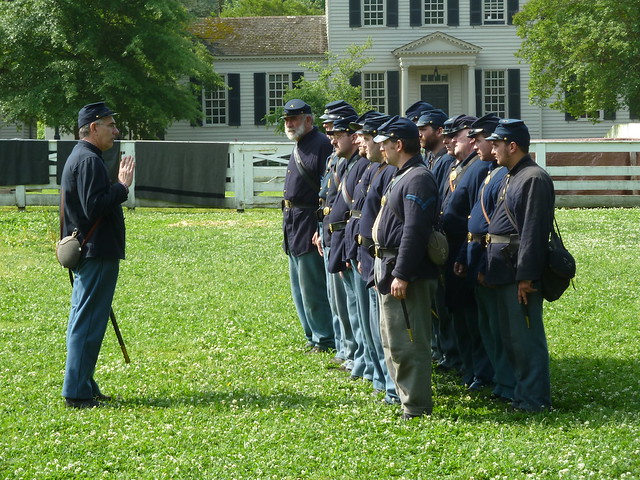
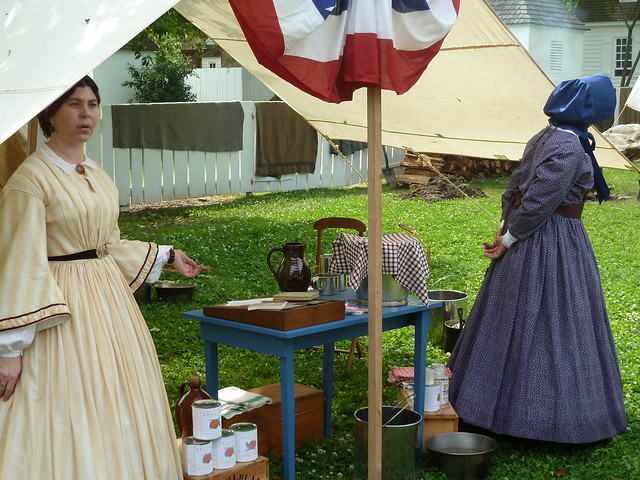
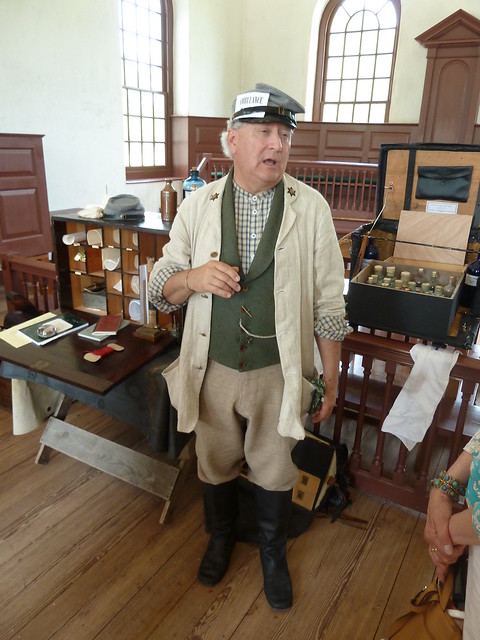
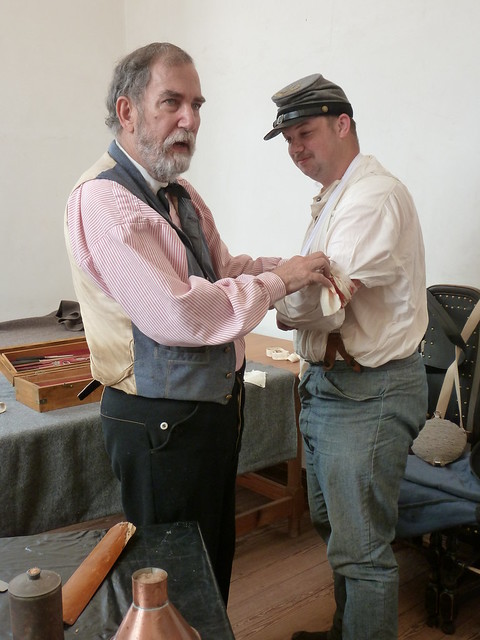
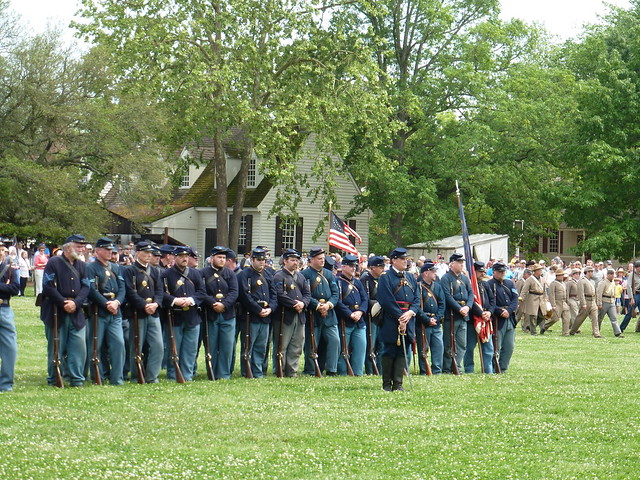
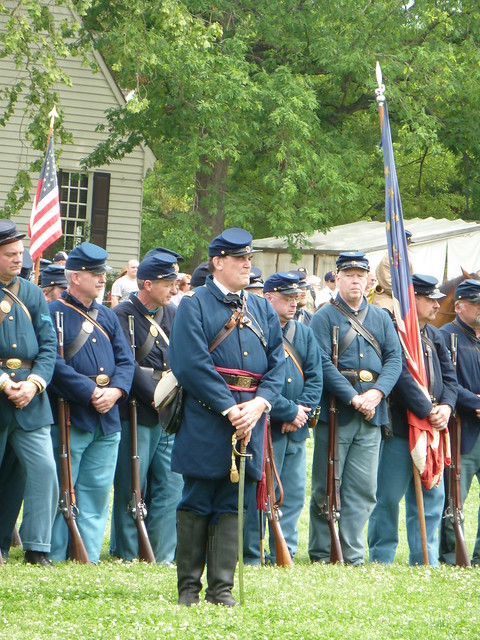
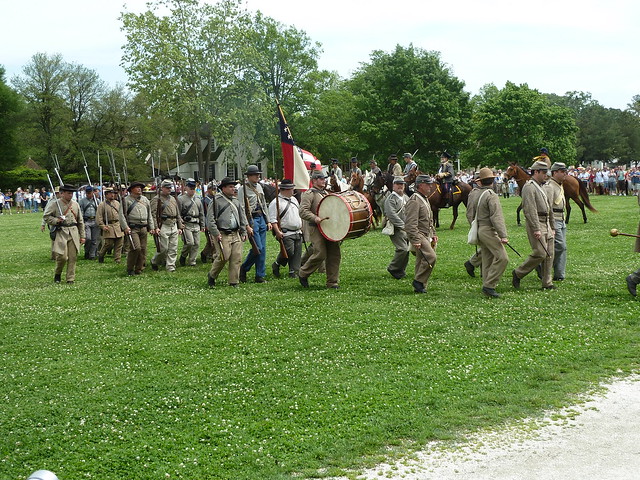

No comments:
Post a Comment